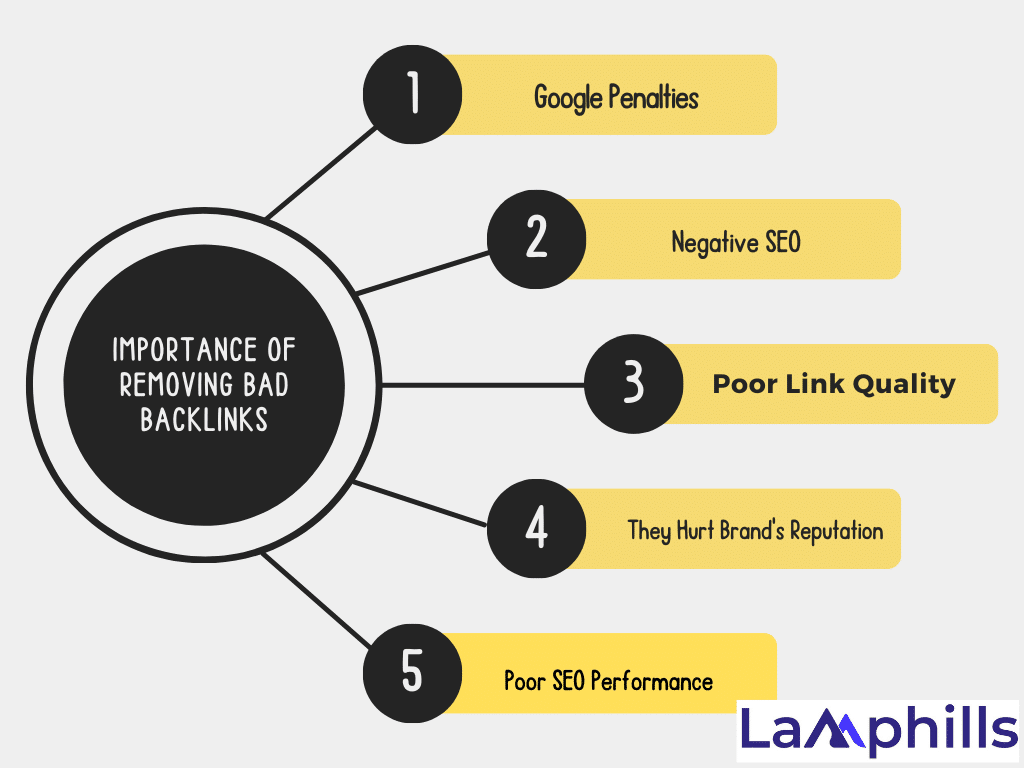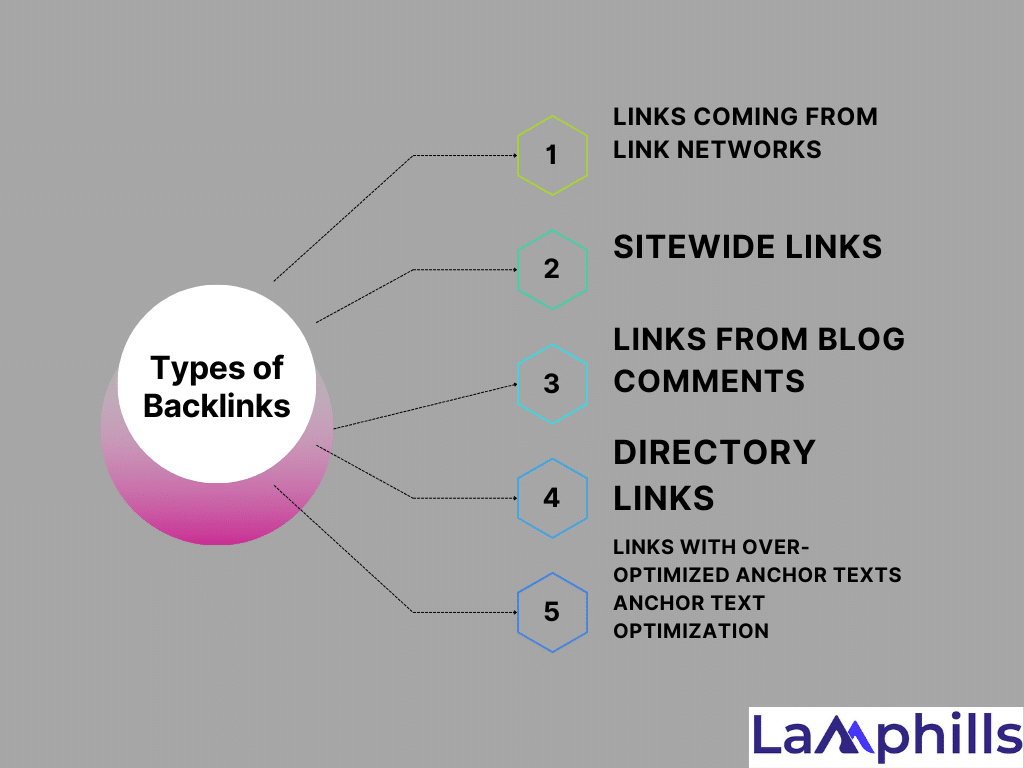Imagine that, after overcoming the challenges of finding the best website developer, you have successfully built your dream website. You’ve spent countless hours polishing each page, and your traffic is starting to increase. Suddenly, your rankings drop. Panic set in. What exactly went wrong? This occurred to Sarah, a friend of mine who owns a thriving online store. Everything seemed wonderful until her website’s visibility dropped overnight. After considerable investigation, we uncovered the culprit: a swarm of harmful backlinks from questionable sources were bringing her site down.
These damaging links can sneak up on you, typically from unknown sites, and wreak havoc on your hard-earned SEO efforts. In this guide, I’ll dive into the world of backlinks—specifically, the identification and removal of harmful ones. This isn’t just about fixing a problem; it’s about safeguarding your site’s reputation and ensuring sustainable growth. So, let’s get started!
Key Takeaways
- Identifying and disavowing these bad backlinks helps protect your site from potential penalties and ensures that your website’s reputation and search engine performance remain intact.
- Regularly auditing your backlink profile is crucial to maintaining a healthy website. Just as a garden needs routine care to prevent weeds from taking over, your website requires consistent monitoring to identify and remove harmful backlinks. Utilizing tools like Ahrefs, SEMrush, and Google Search Console can simplify the process.
- Building a resilient backlink profile involves more than just acquiring links; it’s about securing quality endorsements from reputable sources.
- Several tools can assist in removing harmful backlinks efficiently. For instance, tools like Rmoov, Monitor Backlinks, and Linkquidator are invaluable for identifying and disavowing low-quality links.
What are Backlinks?

Backlinks, often called inbound or incoming links, are links that connect one website to another. See them as digital endorsements. When a credible website connects to your content, it tells search engines like Google that your site is reliable and valuable. For example, if a well-known blog quotes one of your pieces, it is considered a vote of confidence.
Similarly, quality backlinks can increase your site’s authority and search engine rankings. They act as referrals, bringing visitors from other websites and increasing your credibility. However, not all backlinks are created equal. While good backlinks can propel you forward, bad ones can act as anchors and drag you down. By now, you must be wondering what these bad links are, right? A bad link occurs when you or someone on your team creates a connection to another website without first determining the website’s content relevancy, theme relevancy, current authority, and traffic.
Backlinks are one of the most important ranking variables in SEO, as reported by Google SEO Trends for the past decade. However, when attempting to rank rapidly, pages with poor backlinks might be a major source of frustration.
In other words, poor backlinks are a serious worry for websites since they can have a detrimental influence on search rankings and result in fines from search engines such as Google if allowed to accumulate. This is why website owners and SEO specialists go to tremendous lengths to get their sites ranked on the first page of Google and other search engines.
The Importance of Bad Backlinks Removal

Backlinks are an SEO technique used to send visitors to your website through someone else’s site. But if the link is bad, it could bring down the quality of your page in search results for that keyword. Also, because of,
#1. Google Penalties
If your website has a considerable number of low-quality links, search engines such as Google may penalize it. These penalties can lead to a reduction in search rankings or the entire removal of your website from search results. Therefore, knowing how to disavow backlinks reduces the possibility of such penalties.
#2: Negative SEO
In rare situations, competitors or fraudulent actors may build or acquire low-quality backlinks to your website to lower your search rankings. So, disavowing these harmful links informs search engines that you do not endorse or associate with such links, shielding your website from negative SEO tactics.
#3. Poor Link Quality
Bad links from spammy or unrelated sources might reduce your website’s authority and performance. Knowing how to delete bad backlinks ensures that your backlink profile has high-quality, relevant links that support your SEO efforts.
#4. They Hurt Brand’s Reputation
Links from low-quality or spammy websites might hurt your brand’s reputation. Disavowing harmful links contributes to a clean and credible backlink profile, protecting your brand’s image and trustworthiness online.
#5: Poor SEO Performance
Bad backlinks referring to your website have a bad impact on your SEO. However, knowing how to identify and remove problematic backlinks can help you enhance the overall quality and relevance of your backlink profile. This can lead to higher search rankings, increased organic traffic, and improved SEO performance. A strong and healthy backlink profile is essential for long-term SEO success.
Types of Backlinks

There are numerous forms of terrible backlinks, but they all share one trait: they are from low-quality or irrelevant websites. Link farms, spammy directories, and even low-quality blogs can all fall into this category. The problem with these links is that they can harm your website’s ranking by making it appear that you are affiliated with these low-quality sites. The different sorts of harmful backlinks are as follows:
#1. Links Coming from Link Networks
A link network is a collection of connected websites. They are often designed with the express intention of providing you with a huge number of backlinks. They are disguised as blogs or forums, but there are very few hyperlinks to any of their posts or topics. Furthermore, they are likely to contain a large quantity of duplicate material and cross-linking between websites.
When your website gains backlinks from these link networks, search engines consider it questionable conduct. Additionally, search engine spiders frequently de-index link networks and devalue the links linked with them. Google Search Essentials (previously Google Webmaster Guidelines) warns against using such link schemes.
#2. Sitewide Links
These are links that appear on all pages of a website. Typically, they appear in the header, footer, and sidebar sections of a website. For instance, websites developed on WordPress contain a link to WordPress.org in the footer section.
Image via TechCrunch
In the pre-Penguin era, this technique was extensively used by website owners to earn many backlinks quickly. However, it is now considered unnatural and can get your website penalized. It’s much better to have a single backlink from an authoritative domain than many backlinks from a low-authority one.
#3. Links from Blog Comments
If you have ever owned a blog, you might have experienced a flood of spam in the comments section. These comments, which often contain links to other websites, are marked as nofollow to prevent Google from indexing them. When such spam comments link to your website, it affects your inbound link profile adversely.
If you have a comments box on your website, it’s important to monitor it closely to avoid having it filled with spam. If you do find that it’s been inundated with spam, the best course of action is to tag the comments as nofollow. This will prevent Google from indexing them, which can help to protect your website’s inbound link profile.
#4. Directory Links
Web directory submissions are an effective way to earn high-quality backlinks organically. However, this only applies to high-authority directories that are relevant to your niche. If your website has too many backlinks coming from random and low-quality directories, it is likely to get penalized.
Image via Moz
# 5. Links with Over-Optimized Anchor texts Anchor text optimization
As you know, the anchor text of your backlinks is critical to your overall SEO strategy. If you are not attentive, you may end up with a large number of backlinks containing exact match terms. This could result in Google classifying your website as spam, which would be disastrous for your business.
To avoid this, be strategic with your backlinks. Make sure you’re employing a range of keywords and phrases, and don’t rely solely on exact match anchor text. This will help you avoid any potential Google penalties and maintain your website at the top of the search results.
Best Backlinks Removal Tools
Creating poor links is one of the most common mistakes business owners or SEO specialists commit, and if you’re serious about SEO, you’ll understand that creating valuable backlinks is a critical component of a successful SEO plan. If you’ve already made these blunders, you should remove the unnatural links to prevent a Google penalty. After receiving a penalty, you must delete any problematic links as quickly as possible to enhance your SEO rating. To help you, I’m going to reveal a few excellent backlinks removal tools that can help clear up unwanted links.
#1. rmoov
Rmoov is certainly the simplest and most straightforward tool on this list, making it one of the easiest backlink removal tools to use. To get started, simply supply your website’s URL and a valid email account on your domain. This protects against unauthorized individuals deleting backlinks from websites they do not manage. Rmoov will direct you to the actual backlink removal tool after your information has been verified. You merely need to upload the URLs containing the harmful backlinks to your website on this page.
Remember to give the URLs of the specific pages or posts where the link appears. You can also bulk upload backlinks to the program by uploading a CSV file, which would speed up the procedure even further.
#2. Monitor Backlinks
Monitor Backlinks is a comprehensive backlink monitoring tool that can help with all link-related tasks, including competition research and backlink removal. To use Monitor Backlinks for backlink removal, the first step is to set up a queue for your domain. You can do this by connecting your Google Analytics account and assimilating your website data.
Alternatively, you can submit information about your domain or manually include links to other websites. Once you’ve set up a queue, you can start tracking your backlinks. The tool will watch your backlinks and offer you information about each one, such as the anchor text, target URL, and if the link is followed or nofollow. You can use this information to decide which backlinks benefit your website and which harm it. If you believe a specific backlink is damaging, you can request that the website remove it. Monitor Backlinks is a useful tool for any website owner who wants to maintain track of their backlinks and guarantee that they are all beneficial to their website.
#3. Linkquidator
LinkQuidator is an excellent tool for swiftly discovering and disavowing low-quality backlinks. The platform is incredibly easy to use, with a clean and basic UI. To utilize Linkquidator, simply click “Add your new campaign” on the main dashboard and enter your website’s address. Once your website displays as an active campaign, click the green “Start” button to begin searching for damaging backlinks. This tool is an excellent technique to safeguard your website from low-quality links that may harm your SEO results.
Liquidator prices are intended to be both flexible and reasonable. Their ‘pay per backlink’ strategy allows you to change the fee based on the total number of backlinks you must monitor. This is a great option for those who want to keep a close eye on their campaign progress. Alternatively, their ‘self-service’ option lets you input the details of your campaign yourself. This is a great option for those who want to be in control of their campaign from start to finish.
#4. Remove’em
Remove’em “self-service” package enables you to create a domain-level workflow that will quicken the link analysis procedure, as well as control requests for links to be removed.
Simply enter your domain name to get started, and Remove’em will pluck your best backlinks. This makes it easy and convenient to keep track of your link portfolio and ensure that only the highest quality links are pointing to your site.
#5. Linkody
Finally, Linkody belongs to an increasingly rare breed of comprehensive backlink-tracking software. It can monitor your competitors, assess your backlink profile, and track backlinks around the clock.
Despite its extensive features, Linkody’s web dashboard is one of the fastest and most responsive. Linkody, like Monitor Backlinks, gathers a reasonable quantity of information regarding your backlink profile. The link source’s domain Authority, Spam Score, and anchor text are included. The “Analytics” area allows you to produce reports from a variety of datasets. This includes the dispersion of your links’ Spam Scores, which might alert you to a potential link spam attack.
In essence, your website’s inbound link profile has a substantial impact on its search engine ranking. This means if you want to keep your website from getting penalized, you must identify and remove poor backlinks. The best technique is to schedule regular backlink audits so that you can spot any potentially hazardous backlinks and take appropriate action. You can use tools to check for spammy and low-quality backlinks and then delete them. By adopting these proactive steps, you can help your website get a high ranking in search engines.
Steps to Effective Backlinks Removal
If you’re looking to remove bad backlinks, the first step is to perform a complete backlink audit. This will help you identify any toxic links that may be hurting your website’s ranking. Manually checking every link can be extremely time-consuming and tedious. Fortunately, there are a few tools available that can help you filter your backlinks based on different parameters, like the ones I mentioned earlier. Here are key steps to deal with bad backlinks:
#1. Collect Backlink Data
Checking your website’s backlinks is an important aspect of any SEO plan. By understanding where your website is linked, you may attempt to improve those links and boost your overall link popularity. The first step is to create a list of all backlinks to your website from various sources. You can use a variety of tools to accomplish this.
For example, if you want to see which websites link to yours, you can use Google Search Console. Search Console is a free but one of the most useful tools to see your backlinks under the link. When you browse the top connected sites externally, you will see the list of your website backlinks as follows:
#2. Identify Bad Backlinks
As I previously stated, an impartial and comprehensive backlink audit can aid in the removal of spam links from your site. This is the most important stage in removing bad backlinks, and doing it manually can be your best option.
Granted, manually adding thousands of links can be time-consuming and tedious. I recommend using tools to help you filter your backlinks and gain useful insights into them. When you check one, consider whether the link’s content is relevant to your website. If the material is not relevant, the backlink is unlikely to offer any value to your inbound link profile.
Google Search Console’s backlink data does not distinguish between spam and valuable connections; instead, the links are shown without context. However, the SpyFu results will show you the domain strength of the website linking to you. When removing bad backlinks, it is helpful to identify websites with lower domain strength.
You should also search the website on Google. It’s a simple, reliable tactic for good reason. If the website isn’t indexed, Google might be penalizing it, and that is a good indicator of a backlink that should make the “remove” list.
Here’s one more overlooked task: check for the website’s spam score through Link Explorer. Just enter the URL of the website, and you’ll be able to see how that site is seen in regards to its link profile. A website that has a high spam score may negatively affect your SEO efforts.
Image Source: Moz Link Explorer
#3. Remove Bad Backlinks
The next step is to reach out to the owners or webmasters of the websites that are linking to your site with negative backlinks. The goal is to get them to take down the backlinks without making them feel threatened.
Be specific about which backlink you want to remove, and provide instructions on where to find it. There are a variety of ways to find the contact information for webmasters.
You can use a search engine, social media, or other online tools. Once you have the contact information, reach out to the webmaster and explain your situation. Be polite and professional, and most importantly, be confident.
#4. Track and Monitor
Unfortunately, simply sending a removal request to the webmasters of the connected websites is not enough to guarantee that your request will be honored. You must also track the backlinks to ensure that they have been removed. Additionally, you may need to send a follow-up email to a webmaster if they don’t reply within the timeframe you specify.
By taking these steps, you can help to ensure that bad backlinks are removed and that your website’s ranking and reputation are not adversely affected. You can do this with an Excel or Google spreadsheet to list the link, contacts, and date sent. Or, if you are using the SpyFu contact tracking tool shown above, you can add notes about when you reached out. Remember that you can also set reminders in your calendar to contact someone a week later. Set it in advance the day that you send your email, and mark it “done” if they respond before you need to follow up.
#5. Disavow The Remaining Bad Backlinks
Download and make reference to the checklist below
What happens when some of the webmasters don’t respond to your request or refuse to remove bad backlinks? Fortunately, Google allows you to disavow the backlinks you don’t want to be associated with your website.
You will need to build a Google disavow file.
This involves identifying all the harmful backlinks pointing to your website and listing them in a text file format that Google can read.
To get started, you will need to open a text editor on your computer and create a new file for your disavow list. It is recommended that you save this file in .txt format for compatibility with Google’s Disavow Tool.
You can organize your disavow list—for your purposes—by adding comments. If you mark a comment with “#” before it, Google will ignore what you wrote. That gives you the freedom to organize your disavowed domains and individual URLs.
When adding a domain to the list, include the domain name as “domain:website.com” and include “www.” for domains that use it. However, leave out “www” on domains that do not use it. If you only want to disavow specific backlinks from a domain, include the whole URL in the disavow list.
After you’ve created a correctly formatted disavow file, submit it to Google’s Disavow Tool. To do this, go to the Disavow Tool, choose your domain, then click “Disavow Links” and select your disavow file to submit. Once you’ve uploaded your disavow file, Google will re-crawl your site and re-evaluate the links that point to it. While a disavow list will not instantly affect your rankings, it is a necessary step toward enhancing the overall quality of your website’s link profile. It’s also a good idea to establish an Excel spreadsheet to track your submissions.
Best Practices for Preventing Future Harmful Backlinks
Preventing harmful backlinks from plaguing your site in the future is just as important as removing the ones that currently exist. Think of it as pest control for your website: You don’t just want to deal with the current infestation; you also want to make sure new pests don’t invade. Let’s break down how to fortify your backlink profile to keep those toxic links at bay.
A. Building a Strong Backlink Profile
Imagine your website as a beautiful garden. You’ve spent many hours cultivating flowers (generating content), nurturing them (advertising your site), and seeing them bloom (gaining visitors). However, if weeds (bad backlinks) begin to grow, they might choke out the vitality of your lovely landscape. To keep your garden healthy, grow strong, beneficial plants that can outcompete weeds. Here’s how to develop a strong, resilient backlink profile:
#1. Guest Posting
This is like sowing seeds in other parts of the garden to bring some of their beauty back to yours. By writing articles for reputable sites in your niche, you not only share your expertise but also gain valuable backlinks. For example, when I started my business blog, I reached out to a few well-known industry websites and offered to write guest posts. This not only drove traffic to my site but also earned me high-quality backlinks.
#2. Content Marketing
Think of this as creating a fertilizer that makes your plants grow stronger. Creating valuable, shareable content naturally attracts links from other sites. High-quality content acts as a magnet for good backlinks. For instance, when I published a comprehensive guide on SEO strategies, it was picked up by several authoritative blogs and forums in the industry. These organic links were not only beneficial for my SEO but also helped establish my blog as a go-to resource.
#3. Networking

Building relationships with other site owners and influencers in your field is like having a team of gardeners to help keep your garden in check. Networking can open doors to new opportunities for acquiring quality backlinks. I remember attending an industry conference where I met several bloggers and business owners. By staying in touch and collaborating on various projects, we were able to support each other with backlinks, effectively strengthening our respective sites’ profiles.
#4. Social Media Engagement

Think of social media as a protective fence around your garden. Active engagement on platforms like LinkedIn, Twitter, and Facebook can lead to natural backlinks from social shares and increased visibility. When I shared a detailed case study on LinkedIn, it caught the attention of several influencers who linked back to my article in their content.
#5. Influencer Outreach

Collaborating with influencers can provide a significant boost to your backlink profile. When I reached out to an influencer for a quote on one of my blog posts, they not only provided valuable insights but also shared the article with their audience, earning me a few high-quality backlinks from their followers’ websites.
B. Regular Backlink Audits
The checklist below will also be of great benefit for effective backlink audit, so do well to download
Regular audits are like routine check-ups for your garden to catch any potential problems early. This proactive approach helps you spot and remove harmful links before they can do any real damage. Here’s how to keep your backlink profile in top shape:
#1. Monthly or Quarterly Reviews
Set aside time every month or quarter to check your backlinks. Consider examining your garden for weeds and pests. This does not need to be a frightening task. Tools like Ahrefs and SEMrush make it easier to check your backlinks and detect those that are suspect.
For example, every quarter, I spend a day reviewing my website’s backlinks. It’s similar to spring cleaning. I utilize Ahrefs to remove links from low-authority domains or those that have been flagged as possibly harmful. This regular scan allows me to stay on top of any negative SEO concerns and keeps my site healthy.
#2. Using Automated Alerts
Create alerts for new backlinks. This is similar to having a security system for your garden that alerts you anytime there is a new intrusion. Tools like Google Alerts and Ahrefs can notify you anytime a new link goes to your website, allowing you to rapidly assess its quality.
Personal Tip: I have set up Ahrefs alerts for any new backlinks. This allows me to immediately investigate any new links. If they come from suspicious sites, I respond promptly, either through outreach or by adding them to my dislike list.
#3. Analyzing Link Quality
Whenever you discover new backlinks, evaluate their quality. Ask yourself if the linking site is reputable and relevant to your content. This is like checking the quality of new plants before adding them to your garden.
Keep a log of your backlink reviews and actions taken. This helps you track your efforts and measure the effectiveness of your strategies over time.
Personal Practice: I maintain a spreadsheet where I log each backlink review session. I note down the problematic links, actions taken, and any follow-up needed. This record-keeping has been invaluable in ensuring nothing slips through the cracks and helps me track the health of my backlink profile over time.
#5. Engage with Your Linking Sites
For the beneficial links, consider engaging with those sites more. This could mean commenting on their articles, sharing their content, or even collaborating on projects. Building these relationships can lead to more high-quality backlinks in the future.
Example: When I noticed a few high-authority sites linking to my content, I reached out to thank them and suggested potential collaboration opportunities. This not only strengthened our connection but also opened doors for future backlinks and partnerships.
By actively managing your backlink profile and fostering relationships with reputable sites, you can build a robust defense against harmful backlinks. Remember, prevention is always better than cure. A healthy, well-maintained backlink profile will keep your SEO efforts thriving and your site’s reputation intact.
In essence, maintaining your backlink profile is an ongoing process, much like tending to a garden. With regular care and attention, you can enjoy the benefits of a flourishing, resilient website.
While removing toxic backlinks is crucial, it’s equally important to implement best practices to maintain a healthy backlink profile moving forward. Here are some tips:
- Create high-quality, valuable content that naturally attracts backlinks from authoritative sources.
- Engage in ethical link-building practices, such as guest blogging, broken link-building, and content outreach.
- Monitor your backlink profile regularly and address any new toxic backlinks promptly.
- Collaborate with industry influencers and thought leaders to build credible backlinks.
- Participate in relevant online communities and forums, contributing valuable insights and sharing your expertise.
How long until the bad backlinks are removed?
There are various elements to consider before determining the impact of deleting problematic backlinks on SEO results. One is the frequency with which search engine crawlers visit your site. It can take several weeks or months for search engine crawlers to return to your website and re-crawl the revised backlink profile.
What is backlink spamming?
Link spam refers to backlinks that are placed on pages and websites regardless of context or user experience, in an attempt to boost search rankings. Search engines have clear guidelines warning against link spam and will punish or devalue spammy links.
Can you do SEO without backlinks?
It’s possible to rank without backlinks.
How do I know if my backlinks are bad?
Harmful backlinks often come from spammy, irrelevant, or low-quality sites. They might have originated from link farms, paid link schemes, or hacked sites. These links can be toxic and detrimental to your SEO. Here’s what to look out for:
- Irrelevant Links: Links from sites with no thematic connection to your content.
- Low Authority Sites: Links from sites with low domain authority or poor reputations.
- Spammy or Hacked Sites: Links from sites associated with spam or known for hosting malicious content.
Conclusion
The inbound link profile of your website has a significant impact on its search engine ranking. To avoid being punished, you must detect and delete poor backlinks. I understand that removing backlinks isn’t everyone’s idea of fun—it often requires the same amount of blood, sweat, tears, and toil as developing connections, but without the dopamine rush of obtaining a high DR link.
As a result, I’ve thoroughly detailed the methods for discovering them on your site, determining whether they’re spam links, and eventually removing them from your site.
The best practice is to schedule periodic backlink audits to spot any spam links and take the necessary corrective measures. Make it part of your regular site maintenance, and the long-term efforts will pay off.






